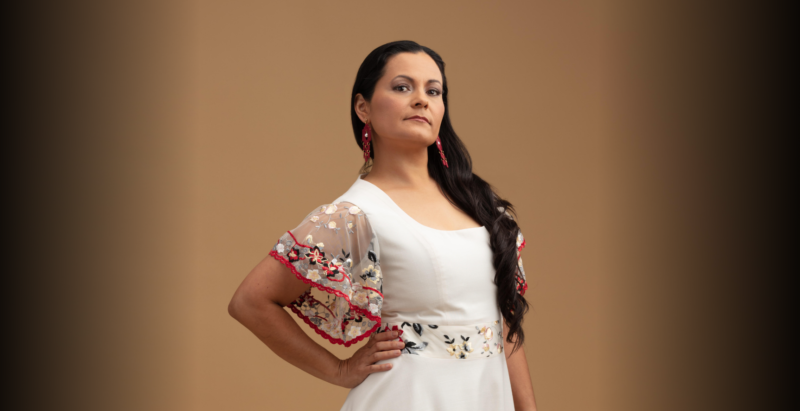Stories of colonial Latin America, for 21st-century Seattle
Review of ¡Navidad! The Mystery of Mary at Pacific Musicworks
Written by TeenTix Newsroom Writer Reagan Ricker and edited by Teen Editorial Staff Member Audrey Gray

With little candles atop wooden coffee tables and the soft murmur of voices from people, as they filed in, Town Hall Seattle was the perfect place to spend a cold December night. But as the audience settled into their seats to see ¡Navidad! The Mystery of Mary, the room was transformed from the streets of Seattle into the rainforests of Latin America with the sounds of various rain shakers and whistlers.
Hosted by Pacific Musicworks, ¡Navidad! The Mystery of Mary is a collection of music entirely dedicated to the “Feminine Divine” of an otherwise predominantly patriarchal church, Mother Mary, by focusing on the bodies of art, poetry, and music that blossomed from Marian traditions on both sides of the Atlantic. This ambitious goal manifested itself in 15 songs, split into 4 respective sections. The show’s program acknowledges this: “These works explore truths far too universal to limit to one creed: the humanity and wonder of motherhood, the desire for comfort in difficult times, and our hope for redemption and healing in a broken world.”
The Mystery of Mary, which sought to showcase the “dynamic blending of European, African, and Indigenous beliefs that characterized Christianity in colonial Latin America,” ultimately accomplished their goal in a way that didn’t comprise the authenticity of any one period or style. Part of their success in doing so came from the compositions themselves, constructing a story chronologically: the audience wasn’t simply observing a musical ensemble but taking part in a series of stories with instruments as the method of narration. Like most stories do, The Mystery of Mary starts at the beginning. Mezzo-soprano Cecilia Duarte, spotlighted in the center of the black stage, sets us up for the performance to come not with singing, but by describing the 1531 Marian apparition of the Virgin de Guadalupe in Mexico City. As the Virgin Mary appeared to Juan Diego on the Hill of Tepeyac to ask him to construct a church in her honor, Cecilia posed to her audience the same question Juan Diego wondered a little over 500 years ago: “Am I worthy of what I’m hearing?”
As the doors of Town Hall finally closed, the rest of the musical ensemble’s eight members readied themselves on the small stage. As Stephen Stubbs turned to the Baroque guitar, Maxine Elainder to the harp, and Antonio Gomez to percussion, the rest of the ensemble picked up on the storyline where Cecilia left off. As we saw a change from polyphonic choral compositions to more homophonic and expressive pieces, we were experiencing in real-time the changes that the music world encountered as it shifted from the Renaissance Era to the Baroque period, and the focus from “exquisite Renaissance motets to boisterous folk dances” that took place in Mexico, Cuba, Guatemala, Brazil, and Peru. As the guitar grew from playful and lilting in one piece to a sorrowful and slowed tune in another, the four acts—Rosa Mistica, Made de Dios, Estrella de Mar, and Reina del Cielo—held our hands as we walked through the changes in historical events and Marian apparitions that accompanied each piece. Throughout each piece, the beauty that emerged from the clarity and power of Duarte’s voice and the ensemble’s playing was undeniable. As I looked around to the rest of the audience who now sat spellbound in their seats, I knew we were all asking ourselves the same question Juan Diego did back in 1531: Am I worthy of what I’m hearing?
Many of the pieces performed, having emerged from the mixing between indigenous, African, and European identities in 18th-century colonial Latin America, were most likely never imagined to be played in 21st-century Washington state. The Mystery of Mary certainly achieved their dedication to past stories and history through traditional percussional elements and the use of the recitative and aria in Duarte’s opera, both defining characteristic features of the Baroque age. Nevertheless, what I found more impressive was how much The Mystery of Mary felt relevant, and most importantly close, even though the pieces were written so long ago.
Part of this was due to the feeling that by the time intermission rolled around, there was no longer an unspoken barrier between the edges of the front row seats and the stage: nothing was separating the storyteller and audience members. We laughed alongside Henry Lebedinsky when he took a break from Harpsichord to unveil a tambourine and mirrored the expressions shared between Baroque violinists Cynthia Black and Tekla Cunningham after each intimate and vulnerable number. There was no music played during intermission but there is something to be said about the artistic nature of the community I found myself fortunate to observe that night. Through commendable storytelling and interaction both in and out of their playing, the audience was not only able to learn about the often under-shown history of colonial Latin America but experience and physically listen to the changes of time through depictions of the Virgin Mary as well.
Perhaps the point of the composition wasn’t meant to force us to question our worth like Juan Diego did in 1531, but instead to appreciate the opportunity to listen to history and acknowledge the beauty and the role of the Virgin Mary in Latin America together one cold December night.

Lead Photo Credit: Cecilia Duarte, courtesy of Pacific Musicworks
The TeenTix Newsroom is a group of teen writers led by the Teen Editorial Staff. For each review, Newsroom writers work individually with a teen editor to polish their writing for publication. The Teen Editorial Staff is made up of 5 teens who curate the review portion of the TeenTix blog. More information about the Teen Editorial Staff can be found HERE.
The TeenTix Press Corps promotes critical thinking, communication, and information literacy through criticism and journalism practice for teens. For more information about the Press Corps program see HERE.


